Nyheter
Les siste nytt fra Proactima her.
Category: News
Norway is not prepared for the management of tomorrow’s risksThe current organization, structures and systems in our national civil protection, emergency preparedness and crisis management work is not suited for managing tomorrow’s risks, Trond Winther and Ivar Lunde claim in this opinion piece.
We live in an uncertain and vulnerable time. Our everyday lives are characterized by financial insecurity. Society is constantly subjected to cyberattacks, and artificial intelligence is changing the world. This summer, our country was cut in half by flooding and landslides, and extreme weather conditions are becoming increasingly common. We experienced an attack on the energy supply in close proximity to us, and critical infrastructure is overloaded. There is war in Europe, and Norwegians are being evacuated from the Middle East.
Increased expectations
We, as citizens, depend on the ability of public authorities to prevent and handle serious unwanted incidents and crises. Society must show a willingness to assume clear responsibility for its most important task – to uphold safety and security, even into an uncertain future.
The 16th of October was the deadline for comments for the Total Preparedness Commission’s report “This is serious.” The Commission proposes that the Ministry of Justice and Public Security should be made responsible for the coordination of crisis management at the national level. At the regional and local levels, the Commission recommends that the County Emergency Preparedness Councils be maintained and that municipal emergency preparedness councils be established by regulation. The proposed council structure has, in actuality, existed for decades and is outdated. The future we have to prepare for, requires that we think outside the box. It is naïve to believe that more of the same will generate new ideas and yield better results.
Read more: Proactima’s response to the Total Preparedness Commission
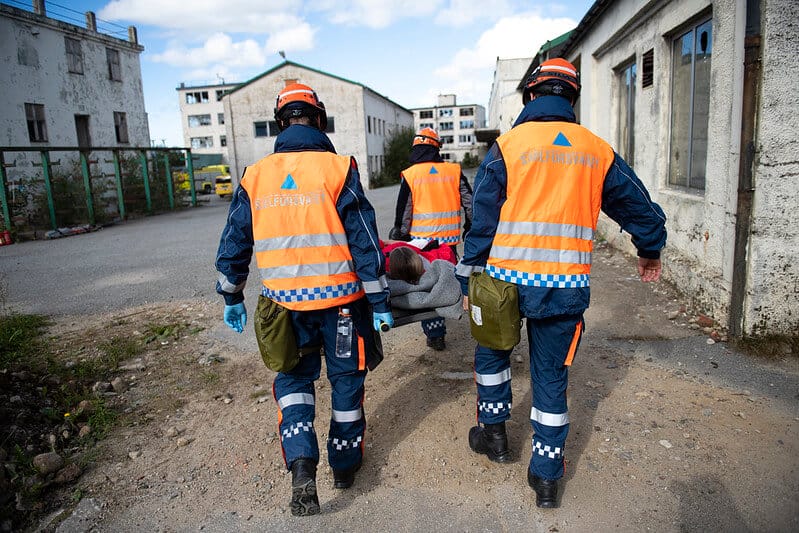
Lack of ability
The Commission’s proposed council structure has limited true influence on the preventative civil protection work and lacks the necessary emergency preparedness and crisis management ability. This structure and system is not suitable for society’s complexity and the rate at which we communicate and provide information now. The existing organizational structure means that actors do not interact effectively enough and that efforts come both too late and with inadequate resources.
During both the refugee crisis and the pandemic, we saw how municipalities and the private sector initially had to handle the situation on their own, with no national guidance or control. When national guidelines eventually did come, they were often inadequate or conflicting. At the same time, the national level, on several occasions, bypassed the ordinary lines of communication and contacted the local level directly, because the flow of communication was too slow. This is a sign of disease in a system that must be functional quickly and effectively when things are urgent and every second counts.
Solutions of the future
New tools, sources of information and means of communication that could make prevention, emergency preparedness and crisis management more effective, are constantly becoming available. To take full advantage of these tools requires knowledge, expertise and professionalism. Civil protection, emergency preparedness and crisis management can no longer be relegated to part-time positions at the municipal, regional or national level.
For the future, it is important that we work comprehensively and systematically with prevention, emergency preparedness and crisis management over time.
Only with expertise, capacity and true resource production at an operational level is it possible to face the complex threats of the future in a responsible manner.
Units equivalent to the Civil Protection House in the City of Bergen is an example of alternative organization. With similar units in recently established civil protection regions, localized in larger cities/regional hubs, regional, operational cooperative centres can establish continuous coordination arenas with the necessary expertise. The proposed council structure can be maintained as an advisory body at a strategic level.
At the national level, a national civil protection coordination centre must be established, based on the principles behind the Civil Protection House, and the regional centres can continuously report here. This way, we can have a structure and a system that effectively can:
1. maintain the necessary situational understanding and develop situational awareness for decision-makers through continuous monitoring of the dynamic risk picture, and
2. have the operative ability to: a) identify hazard and threat events early enough to prevent these from developing into serious unwanted incidents, and respond early and effectively with sufficient resources to minimize suffering and the consequences of incidents that do occur.
The civil protection regions can consist of one or more counties and include all municipalities in the region. This way, local and regional authorities, emergency services, infrastructure owners, the private sector and volunteers can work together effectively in the same regional coordination arena.
It is urgent. It is essential that we establish robust civil protection regions with the competence, capacity and professionalism to work comprehensively and systematically with the region’s civil protection issues in close collaboration with the public and private sectors and volunteer organizations, continuously and over time.
—
Trond Winther has extensive experience with managing large risk management projects, both here in Norway and abroad. He has been an executive in the consulting industry for many years, and since 2018, he has been CEO of Proactima AS.
Ivar Konrad Lunde has a background from the Armed Forces and the police. He has been the Head of Emergency Preparedness for the City of Bergen and the Director of the Civil Protection House. As author of the popular textbook “Praktisk krise- og beredskapsledelse”, Universitetsforlaget, 2019, he teaches at universities and university coleges, and he has a part-time position as an assistant professor at Nord University.
Input on framework for offshore wind
Proactima urges the Ministry of Petroleum and Energy to set higher requirements for HSE (Health, Safety, and Environment) in the pre-qualification process for offshore wind power.
In the realm of sustainability, Proactima hopes that the ministry will both include requirements in the Transparency Act and set expectations that offshore wind turbines, upon completion, should meet the criteria outlined in the EU Taxonomy.
1. Proactima has provided the following input for the consultation on pre-qualification criteria for the ministry’s work on allocation in Utsira Nord and the initial areas in Southern North Sea II:
Proactima believes that concession allocations should incentivize actors to promote and further develop a high level of safety and working environment within their operations. Proactima notes that pre-qualification criterion 2E concerning HSE is very concise and only allows for an assessment based on pass/fail for minimum requirements. In the subsequent allocation model, HSE is not weighted beyond meeting the minimum requirements.
Given that bottom-fixed and floating offshore wind in Norway is an immature industry, while there are ambitious plans to develop it into a comprehensive activity, it is crucial to provide incentives to promote and further develop a high level of safety and working environment within the industry.
HSE regulations for offshore wind are still being established, with varying expectations among actors regarding necessary content. The concession allocations can contribute to fostering expectations and practices that are tailored to the risk conditions, the actor landscape, and the industry’s maturity. Additionally, they should align with the industry’s competitiveness nationally and internationally.
We believe that concrete initiatives and activities should be requested from actors regarding how they will promote and further develop a high level of safety and working environment within their operations, and that this should be included in the prioritization within the allocation model. Relevant topics for assessment may include:
- Description of an HSE strategy demonstrating strength, willingness, and competence to achieve a high level of safety and working environment.
- Initiatives to establish a robust safety culture and practices in project development, construction, installation, operation, and potential decommissioning.
- Initiatives to establish, build, and share knowledge about risk conditions and best practices within the industry. It is indicated that the industry lacks sufficient sharing of experiences related to HSE and incidents.
- Initiatives to establish a collective mapping of various HSE risk conditions within the industry.
- Description of how different development concepts will be evaluated with regard to HSE and working environment, and how HSE will be weighted in the choice of concept.
Actors must be capable of delivering good HSE performance, partly because this industry will not be risk-free, and partly because the foundation of risk assessment is incomplete. Furthermore, floating offshore wind in Norway is different and more complex than what has been done elsewhere in the world.
2. Proactima believes that the ministry needs to clarify how the responsibility for HSE should be addressed within a consortium.
The consultation document describes that a consortium can collectively meet the pre-qualification requirements. Proactima believes that there should be requirements to describe how the responsibility for HSE and risk management, including the management system, should be comprehensively addressed within a consortium. This will ensure that actors work proactively and systematically with these aspects and establish clear and unambiguous lines of responsibility to effectively manage HSE and risk.
3. Proactima hopes for a stronger sustainability dimension.
Proactima acknowledges that the allocation criteria emphasize the sustainability dimension, with a particular focus on the recycling and reuse criterion contributing to increased attention and operationalization of the circular economy. In addition to the expectation of compliance with environmental legislation, Proactima hopes that the ministry will specifically include requirements in the Transparency Act. This act sets requirements for the implementation and follow-up of decent working conditions and human rights in the value chain during project development. Lastly, Proactima expects the ministry to set expectations that offshore wind turbines, upon completion, should meet the criteria outlined in the EU Taxonomy, as proposed in future legislation on sustainability and sustainability reporting.
Les vårt høringsinnspill for Sørlige Nordsjø II.
Les vårt høringsinnspill for Utsira Nord.
Businesses must do the transformation talkAs we enter 2023, Trond Winther takes a look into the crystal ball and writes in Stavanger Aftenblad about six trends that will shape our society in the new year.
We leave behind a year of unrest in the world. There is war in our neighboring regions, democracy is under pressure, there is global polarization, challenging economic times, digitalization continues in full swing, and climate change looms over us. As we enter 2023, it is time to gaze into the crystal ball.
1. The battle for resources sharpens security on the Norwegian continental shelf
The gas leak in the Baltic Sea and increased drone activity in the North Sea have placed security at the top of the agenda. Norwegian oil and gas installations have been designated as vulnerable targets for terrorism. And there has never been a greater reason to disrupt Norwegian gas delivery to Europe than now. This poses greater and more complex demands on security and preparedness.
2. Higher expectations and stricter regulatory requirements
There is increased focus on compliance with existing regulatory requirements in risk management, preparedness, and sustainability. It is crucial for businesses that want to maintain or strengthen their position to establish and maintain good systems, procedures, and a culture of responsible risk management and preparedness. In the field of sustainability, the new regulations with the catchy name EU Taxonomy have just come into effect in this country. The most obvious consequence of stricter regulatory requirements is higher demands for reporting. And this is probably just the beginning.
NEW SECURITY THREATS CHALLENGE US TO THINK DIFFERENTLY. IT’S ALL ABOUT UNDERSTANDING AND MANAGING RISK. AND THE GREATEST CURRENCY IS KNOWLEDGE.
3. A world in an energy war
The energy crisis in Europe is prompting the EU to accelerate the green transition to become less dependent on natural gas. In the long run, Europe must scale up renewable energy resources on a large scale. This means that electricity consumption must be made more efficient while society electrifies. At home, this leads to the emergence of new industries such as hydrogen and offshore wind power, and perhaps greater deliberations on further development of onshore wind power.
4. The need for sustainable transformation
Prices of goods and services have risen at a pace we haven’t seen in decades in 2022. Inflation is largely supply-driven, where lower energy supply leads to increased prices. The paradox is that the Norwegian economy is doing well. Raising the policy rate in fear of expansive fiscal policy becomes the solution. Therefore, transformation, the green shift, and a sustainable economy are necessary to alleviate the pressure on the economy.
5. More extreme weather to come
Human-induced climate change is leading to more landslides, avalanches, floods, and storms. The insurance industry is already paying out staggering amounts related to natural disasters. We know that we need to adapt to climate change in the way we build our society, but it’s worth questioning whether the staggering insurance sums are due to bad weather or poor planning.
6. Trust under pressure
Politicians and leaders are tasked with addressing challenges in climate and sustainability, digitalization, power, and the economy, where trust plays a central role. Trust is one of the greatest currencies we have in Norway and has been highlighted as one of the success factors in pandemic management. High electricity prices, shrinking inflation, and price growth can challenge the green transition. And for many, it’s challenging to see how society can electrify when prices are already so high. For politicians and leaders, it’s a challenge to provide a realistic answer to how this can be resolved.
What can we do?
New security threats challenge us to think differently. It’s all about understanding and managing risk. And the greatest currency is knowledge. 2023 will also be an uncertain year. With the EU Taxonomy on the horizon, financial markets are becoming linked to sustainable transition. For the calendar year 2023, we must continue to prepare ourselves for transformation, the green shift, and a sustainable economy. Society and businesses will engage in transformation for the foreseeable future. Businesses that do not already have realistic ideas about how they will contribute to sustainable transformation will be left behind. And to succeed, digitization must be part of the plan. We at Proactima will do our part.
Security advisory agreement with the Norwegian ParliamentProactima has entered into an agreement with the Norwegian Parliament to assist with security counselling.
“This is a very important agreement for us”, says CEO Trond Winther in Proactima. “We appreciate very much the confidence given to us by the Parliament, by assigning this framework agreement to Proactima”.
The framework agreement includes assessments and analyses, investigation of measures and implementation within the areas which is covered by the Security Act and the security area. This includes personnel security, information security, internal audits, value assessment, risk assessment and security risk assessments.
Proactima has received this agreement together with our partner for many years, the Aeger Group, which is subcontracted to Proactima in this assignment. The agreement has a duration of two years with options for extension.
We are looking for Frontend and Fullstack developers for our team!We are investing in the digitalisation of our subject areas, and therefore we are looking for Frontend and Fullstack developers for our development team in Stavanger. We are looking for you who want to help develop a modern self-service solution for digitizing work processes in the global market.
With us, you become part of a small but very dedicated team, which will grow in the long run. The team is based in Stavanger, so we are looking for you who live in the Stavanger area or want to move.
Our platform UXRisk is a cloud-based (Azure) digitization solution which operationalizes the work processes in a company. We have clients in the transport, energy, oil and gas, and land-based industries, mainly from Europe, which vary in size from 20 to 20,000 employees.
Read more here for more information, get in touch if you have a question or send us an application!
The Port of Narvik in northern Norway needs a new workboat which should be both fast and emissions-free. Proactima together with eight project partners, are now seeking public funding to build one of the world’s first hydrogen-powered, high-speed vessels.
The boat will be equipped with hydrogen fuel cells from TECO 2030,which will be leading the project, and will be built by the shipyard Grovfjord Mekaniske Verksted (GMV), located near Narvik.
When completed, the boat will replace one of the port’s diesel vessels. As a result, the Port of Narvik will be able to reduce both its diesel consumption and its CO2 emissions significantly.
“This is an exciting project for us”, says CEO Trond Winther in Proactima. “Hydrogen will be key to reducing greenhouse gas emissions from the maritime industry and we are pleased to be able to contribute. In the project Proactima will be responsible for risk assessments and analyses to ensure that it will be safe to use”, underlines Trond Winther.
The boat is planned to be completed in 2023. The Port of Narvik will mainly use it for keeping an overview of the port and the activities there, for emergency preparedness, and for teaching and training of crews.
The Port of Narvik aims to get the boat classified as a long-range, high-speed passenger vessel, and the plan is that it should be able to keep a pace of 23 knots.
Green transition in the maritime industry
Norway aims to reduce emissions from domestic shipping by at least 50% by 2030, compared with 1990. This target should be reached through a stronger focus on the development of low- and zero-emission solutions, and by setting emission requirements for ships operating on Norwegian fjords.
Norway plans to introduce requirements for low- and zero-emission solutions in public tenders to speed up the green transition in the maritime industry.
Moreover, from 2026 only zero-emission cruise ships and ferries will be allowed entry into the Norwegian world heritage fjords.
Ships operating in Norwegian waters will therefore have to reduce their emissions and become more climate-friendly.
The vessel’s fuel cells will be produced in Narvik
The fuel cells that will ensure the boat’s propulsion will be produced at the TECO 2030 Innovation Center in Narvik and will enable it to operate emissions-free.
In addition to Proactima, the following organisations will participate in the project: The maritime engineering company BLOM Maritime, the hydrogen supplier Everfuel, the consultancy KUPA, and the company Norinnova Narvik, which specialises in commercialising research results, are also partners in the project.
BLOM Maritime will provide technical assistance to Grovfjord Mekaniske Verksted during the building of the boat.
Knowledge dissemination will be an important part of the project, and KUPA will focus on disseminating the knowledge about hydrogen boats that will be developed during the boat’s building and testing phase. KUPA is leading a maritime technology cluster in Norway and will pass on lessons learned in the project to its members.
Hydrogen filling station for ships and road transport
The hydrogen boat will become Narvik’s first hydrogen consumer and will need to be refuelled on a regular basis. The project therefore also involves the establishment of a hydrogen filling station.
Everfuel will seek to develop this filling station. The company is currently working to establish hydrogen filling stations for trucks, buses and other heavy-duty transport all across Norway.
Other users of the port will also be able to use the planned filling station in Narvik. About 500 trucks drive through the city every day, and the filling station will therefore not solely be intended to cater for sea traffic.
The goal is that it will become the world’s first hydrogen filling station that can serve both ships and road traffic, and that its establishment will make it possible for more companies and people in the region to switch to climate-friendly hydrogen.
Everfuel will now, together with UiT and Norinnova Narvik, work to find possible new hydrogen users within the municipality and county municipality, such as buses, waste collection vehicles and taxis.
In addition, UiT Narvik will participate in the project as a research partner, with the aim of gaining expertise in maritime hydrogen systems. This will ensure that they can provide education that will enable their students to become valuable potential, future employees of the partners in the project.
UXRisk Release 12A new release of UXRisk has arrived. The new version contains some new functionality and fixes some known bugs.
The UXRisk team hopes you enjoy the latest version of UXRisk. Do not hesitate to get in touch if you have questions or would like a demo.
Editable tables, wherever you are
You can now edit and update articles, or sub-articles – eg risks and actions directly in the search tables. This makes it significantly easier and more efficient to follow up on your cases and tasks. Editability is turned off by default and a button appears at the top of each table that can enable editability.
Of course, change log is also taken care of for these changes.
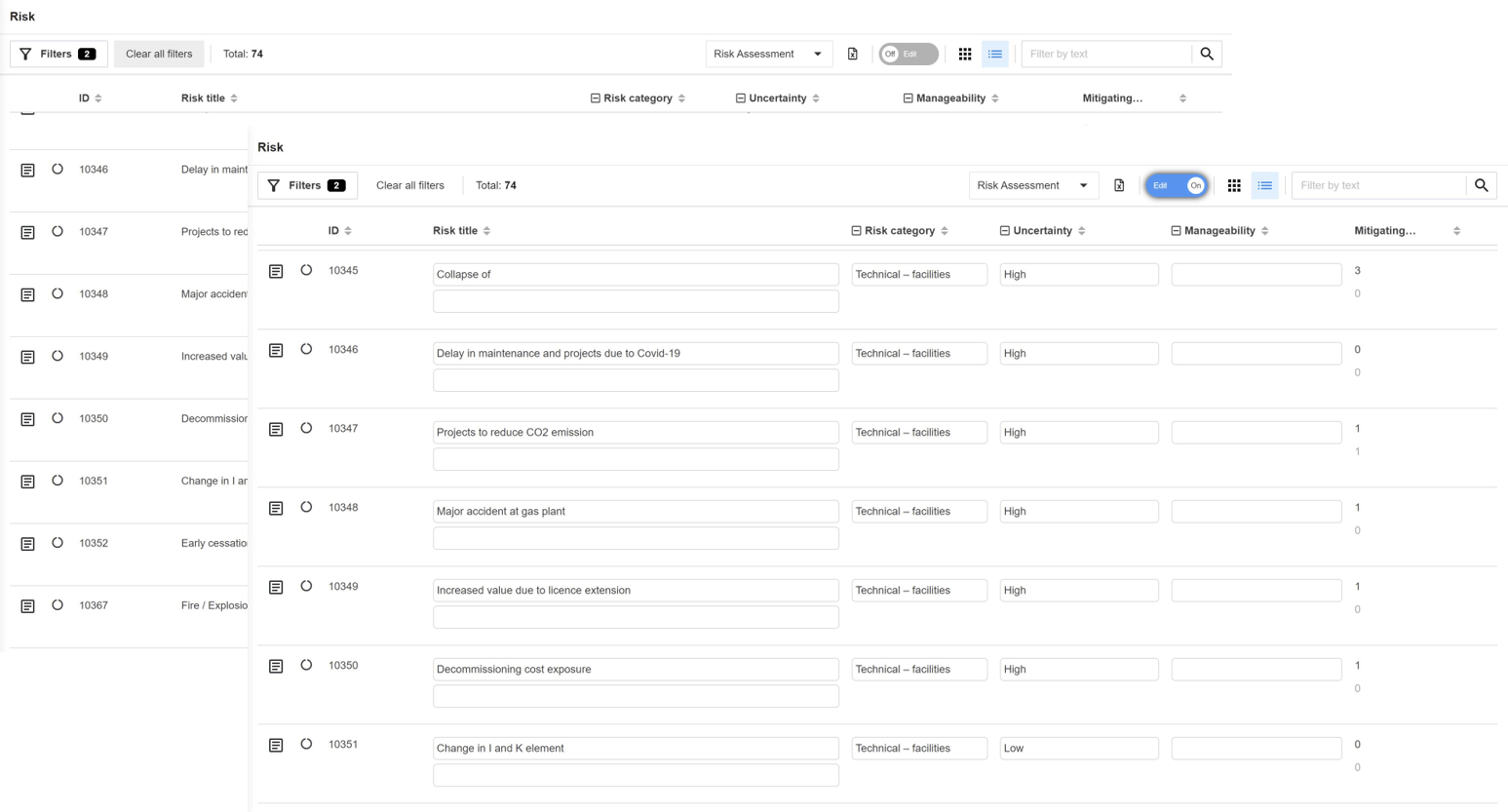
Duplication of articles
All articles in UXRisk can be duplicated. Now you can also choose how you want to duplicate, either by making an exact copy or by customizing. For example: Let's say you want to make a new version of a risk analysis, then you can either make an exact copy of the previous one, or choose what you want to take with you to the next edition.
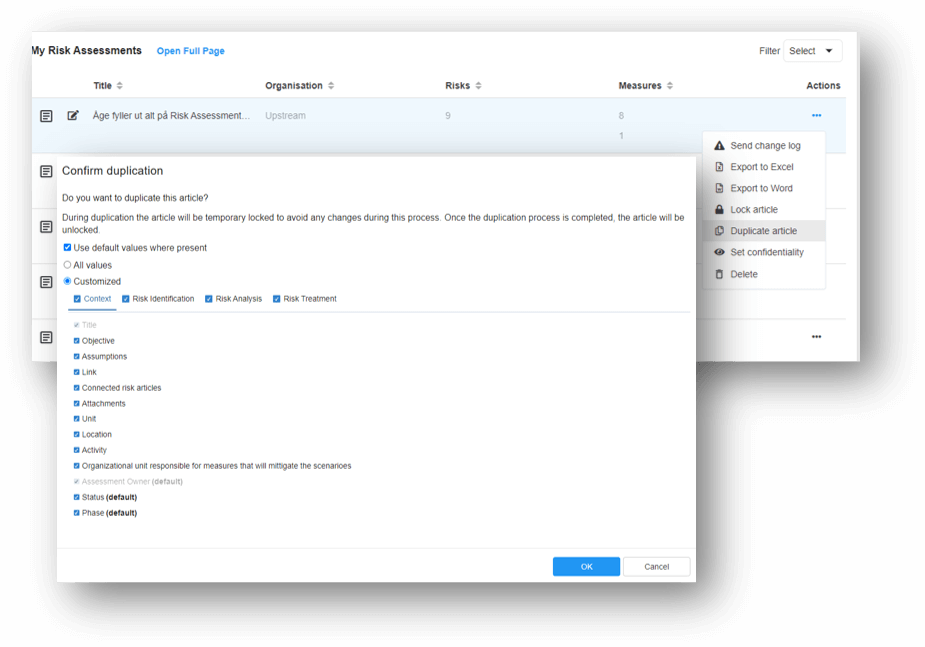
Expand / Collapse in forms
When you have to work with complex or large forms of information, they can quickly become confusing. We are now presenting a new concept for being able to work in sections. As an example, you can now have a section for description, categorization and details and easily navigate between them or collapse the ones you are not using.
This functionality must be set up for each application where this is needed.
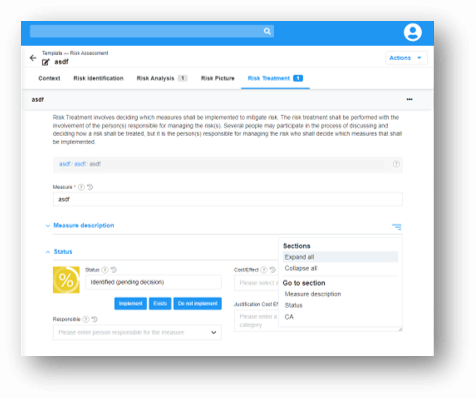
We are happy to announce a new release of UXRisk. The new release contains some new functionality and a number of fixes to known bugs.
The UXRisk team hopes you will enjoy the newest version of UXRisk. Please do not hesitate to get in touch if you have any questions.
Pop-up dialog for child articles
In fields where adding child articles, like Risk Identification and Measure identification, a Modal Dialog will occur when clicking on the items instead of going to the Risk/Measure picture for each item. This will make it way more effective and intuitive when working with child articles.
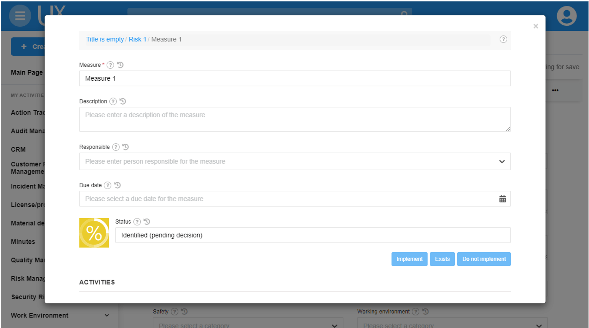
Remember the detailed position in table/wizard zooms
When manoeuvring in UXRisk between pages/tabs, UXRisk will now remember where the user was the last time the page/tab was entered. This leads to time saved and gives a much better user experience.
Add second (or lower) child articles
When adding child articles like Risk and Measures, the user used to always enter the new values in a text field (and click enter). Now the Risk, Measures etc. can be added directly in the table view.

Full keyboard support
Possible to use UXRisk without having to use the mouse. The TAB button can be used to move around on the page, and ENTER and SPACE can be used to click on buttons etc.
Proactima has signed a new frame agreement with SkanskaProactima has signed a new frame agreement with the construction company Skanska.
“We appreciate very much this agreement with Skanska”, says Trond Winther, CEO in Proactima. “We have worked for Skanska during the last six years and are very proud to receive renewed confidence. Proactima has previously worked with occupational health issues for the company and is very pleased the assignment now has been expanded to include several other services. This gives us a good foundation for further improvement and development of our services”.
“Skanska is an exiting company which is focusing on the environment and sustainable solutions. In Proactima these are also highly important issues which we will focus extensively in the times to come. We therefore believe we can be a good contributor to Skanska’s ‘green’ construction focus”, says Winther.
The frame agreement with Skanska has a duration of three years and includes among others:
Health and working environment
Emergency preparedness and training
Safety/security
HSE counselling – risk and analysis
Revisions, auditing, and supervision
Management systems
“We are a large business in a demanding industry where critical risks are handled continuously and on a daily basis, in every of our at all times approximately 150 projects” underlines Peer Chr. Anderssen, HSSQ director in Skanska Norge. «To us it is important to have a well-established partner with key competence and capacity where we have limited resources. The frame agreement with Proactima reflects the differences in our challenges and the broadness of Proactima’s competence”.
«Proactima has a long and extensive experience with these competence areas with deliveries to several sectors and important community companies in Norway”, underlines Bror Johan Tørneng Wik, head of Health and Working Environment in Proactima. “We also have experience from other construction industry assignments”.
We look forward to a continued cooperation with Skanska!
